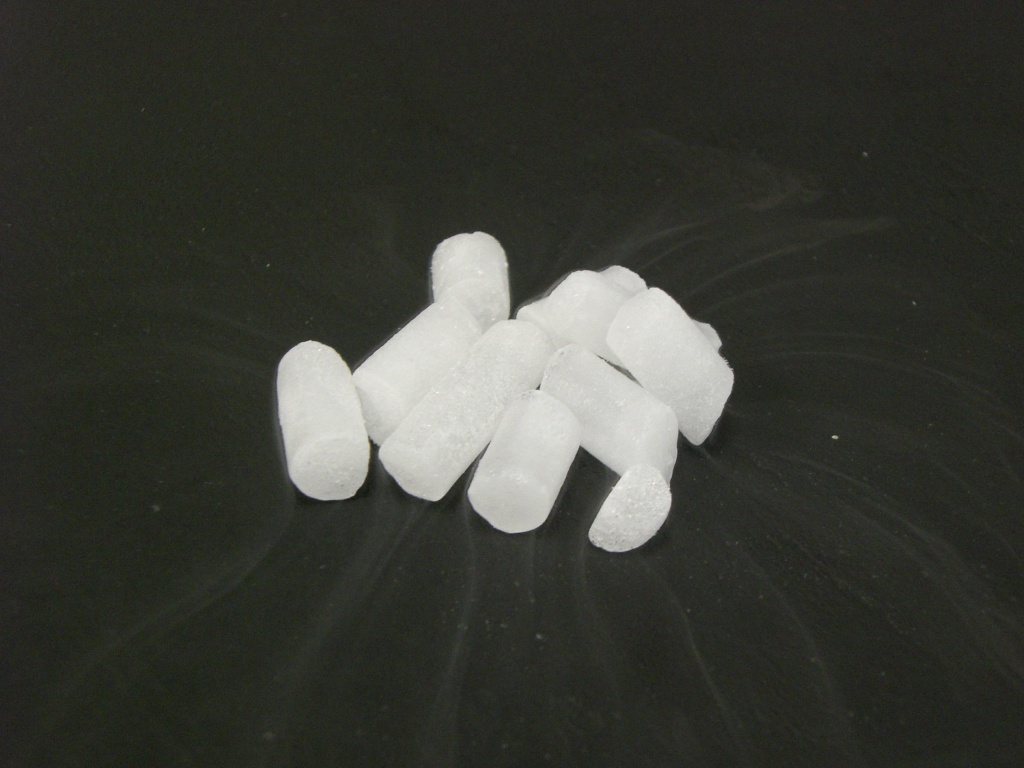Sublimation (chemistry)
Overview
Sublimation of an element or compound is a transition from the solid to gas phase with no intermediate liquid stage. Sublimation is a phase transition that occurs at temperatures and pressures below the triple point (see phase diagram).
At normal pressures, most chemical compounds and elements possess three different states at different temperatures. In these cases the transition from the solid to the gaseous state requires an intermediate liquid state. However, for some elements or substances at some pressures the material may pass directly from solid to the gaseous state. This can occur if the atmospheric pressure exerted on the substance is too low to stop the molecules from escaping from the solid state.
The opposite of sublimation is deposition. The formation of frost is an example of meteorological deposition.
Examples

Some substances (such as zinc and cadmium) will sublime at low pressures and thus may be a problem encountered in high-vacuum applications.
Carbon dioxide is a common example of a chemical compound that sublimes at atmospheric pressure—a block of solid CO2 (dry ice) at room temperature and at atmospheric pressure will turn into gas without becoming a liquid. Iodine is another example of a substance that produces fumes on gentle heating. In contrast to CO2, though, it is possible to obtain liquid iodine at atmospheric pressure by controlling the temperature at just above the iodine's melting point. Snow and other water ices also sublime, although more slowly, at below-freezing temperatures. This phenomenon, used in freeze drying, allows wet cloth to be hung outdoors in freezing weather and retrieved later in a dry state (although strong sunshine is required to drive the process.) Naphthalene, a common ingredient in mothballs, also sublimes easily. Arsenic can also sublime at high temperatures. Sublimation requires additional energy and is an endothermic change. The enthalpy of sublimation can be calculated as the enthalpy of fusion plus the enthalpy of vaporization.
Other substances, such as ammonium chloride, appear to sublime because of chemical reactions. When heated, it decomposes into hydrogen chloride and ammonia, which quickly react to reform ammonium chloride.
Sublimation purification
1 Cooling water in 2 Cooling water out 3 Vacuum/gas line 4 Sublimation chamber 5 Sublimed compound 6 Crude material 7 External heating
Sublimation is a technique used by chemists to purify compounds. Typically a solid is placed in a vessel which is then heated under vacuum. Under this reduced pressure the solid volatilizes and condenses as a purified compound on a cooled surface, leaving the non-volatile residue impurities behind. This cooled surface often takes the form of a cold finger. Once heating ceases and the vacuum is released, the purified compound can be collected from the cold surface. Usually this is done using a sublimation apparatus.
Uses
Frost-free freezers work by having a fan and air circulation inside the freezer. The sub-zero temperature combined with the air circulation that keeps the air arid significantly accelerates the sublimation process. This keeps freezer walls and shelves free of ice, although ice-cubes will continually sublimate.
Dye sublimation is also often used in colour printing on a variety of substrates, including paper. A small heater is used to vaporize the solid dye material, which then solidifies upon the paper. As this type of printer allows extremely fine control of the primary color ratios it is possible to obtain a good quality picture even with relatively low printer resolution, as compared to other printer types of similar resolution. Standard black and white laser printers are capable of printing on plain paper using a special "transfer toner" containing sublimation dyes which can then be permanently heat transferred to T-shirts, hats, mugs, metals, puzzles and other surfaces.
In alchemy, sublimation typically refers to the process by which a substance is heated to a vapor, then immediately collects as sediment on the upper portion and neck of the heating medium (typically a retort or alembic). It is one of the 12 core alchemical processes.
In the Fast-Freeze, Deep-Etch technique, samples (for example, tissue samples) are rapidly frozen in liquid nitrogen and transferred to a vacuum device in which surface ice is sublimed. This effectively etches the sample surface, revealing the preserved 3D structure of the hydrated material. A rotary shadowed surface replica can then be obtained via electron microscopy.
Sublimation is also used to create freeze-dried substances, for example tea, soup or drugs in a process called lyophilization, which consists in freezing a solution or suspension and heating it very slowly under medium to high vacuum - specifically, a pressure lower than the vapor pressure of the solvent at its melting point. This can be well under the melting point of water if there are organic solvents or salts in the sample being freeze-dried. The resulting solid is usually much easier to dissolve or resuspend than one that is produced from a liquid system, and the low temperatures involved cause less damage to sensitive or reactive substances.
See also
From To Solid Liquid Gas Plasma Solid Solid-Solid Transformation Melting Sublimation - Liquid Freezing N/A Boiling/Evaporation - Gas Deposition Condensation N/A Ionization Plasma - - Recombination/Deionization N/A
ar:تسامي bg:Сублимация ca:Sublimació cs:Sublimace da:Sublimation (faseovergang) de:Sublimation (Physik) el:Εξάχνωση eo:Sublimado fa:تصعید it:Sublimazione he:המראה (פיזיקה) lv:Sublimācija lt:Sublimacija nl:Sublimatie no:Sublimasjon nn:Sublimasjon simple:Sublimation sk:Sublimácia sl:Sublimacija fi:Sublimoituminen sr:Сублимација (физика) sv:Sublimering th:การระเหิด uk:Сублімація (фізика)